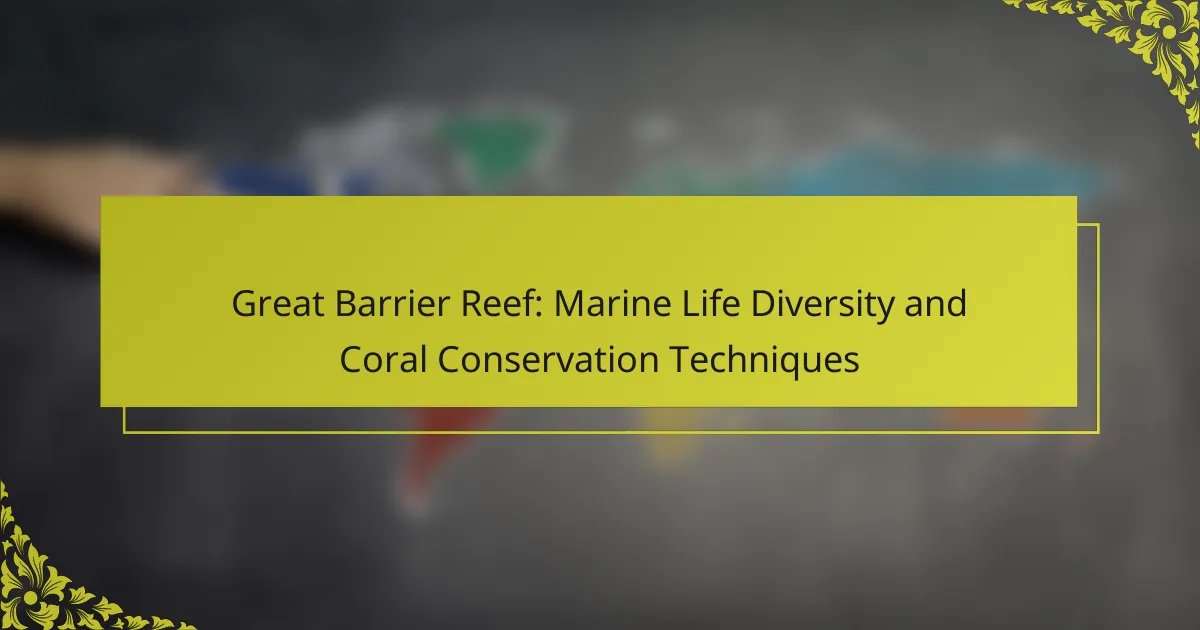The Great Barrier Reef is vital for marine biodiversity, but it faces significant threats from climate change, pollution, and overfishing. This article explores the diverse marine life within the reef, examines the impact of environmental challenges, and highlights effective coral conservation techniques. Community involvement and sustainable tourism practices are also essential for preserving this unique ecosystem and its endemic species.
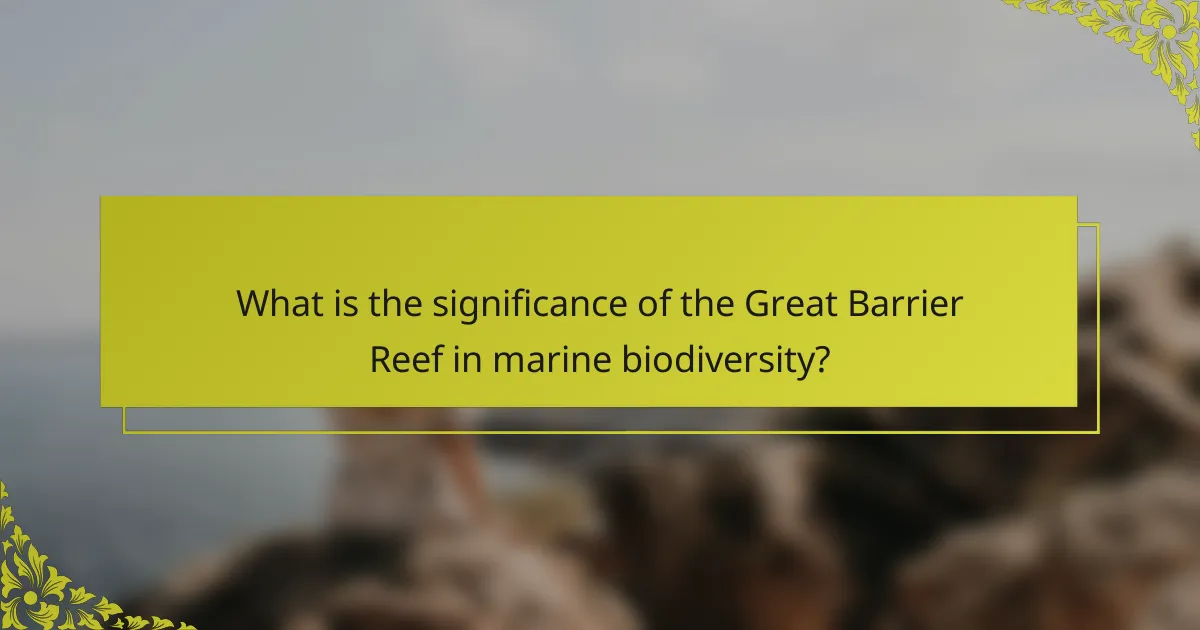
What is the significance of the Great Barrier Reef in marine biodiversity?
The Great Barrier Reef is crucial for marine biodiversity, hosting thousands of species. It supports diverse ecosystems and provides habitat for fish, corals, and other marine organisms. This biodiversity is vital for ecological balance, tourism, and fisheries. Coral conservation techniques, such as reef restoration and monitoring, help maintain this diversity, ensuring the reef’s health and resilience against climate change.
How does the reef support various marine species?
The Great Barrier Reef supports various marine species by providing essential habitats and resources. Its diverse ecosystems, including coral reefs, seagrass beds, and mangroves, create unique environments for countless marine organisms. Coral reefs serve as breeding grounds and nurseries for fish, while seagrass beds offer shelter and food for species such as turtles and dugongs. Additionally, the reef’s complex structure enhances biodiversity, allowing for a rich variety of life forms to thrive. Conservation techniques, such as reef restoration and sustainable fishing practices, further enhance the reef’s ability to support marine life.
What are the key ecosystems within the Great Barrier Reef?
The Great Barrier Reef comprises several key ecosystems, including coral reefs, seagrass beds, and mangroves. Coral reefs serve as biodiversity hotspots, hosting thousands of marine species. Seagrass beds provide essential habitats and food sources for various marine life. Mangroves protect coastlines and support nursery habitats for juvenile fish. Each ecosystem plays a crucial role in maintaining the overall health of the reef system.
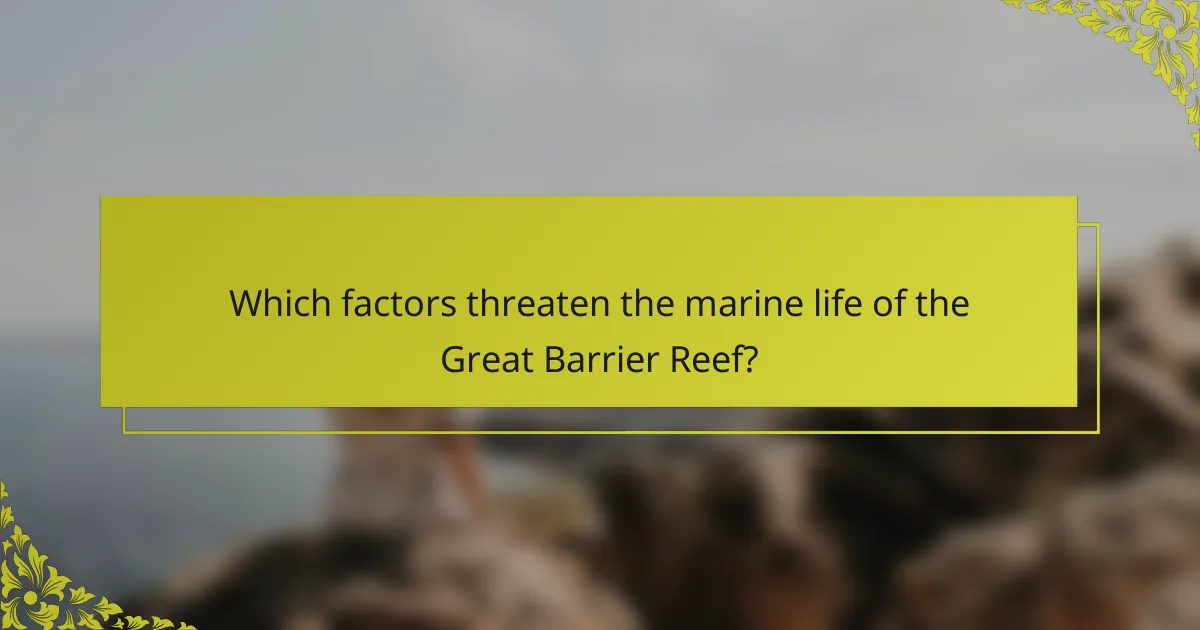
Which factors threaten the marine life of the Great Barrier Reef?
Climate change, pollution, overfishing, and invasive species threaten the marine life of the Great Barrier Reef. These factors disrupt ecosystems, leading to coral bleaching and loss of biodiversity.
Climate change raises ocean temperatures, causing widespread coral bleaching. Pollution from agricultural runoff introduces harmful nutrients, promoting algal blooms that suffocate corals. Overfishing depletes key species, disrupting the balance of marine life. Invasive species outcompete native organisms, further threatening local biodiversity.
Each of these factors uniquely impacts the reef’s health, emphasizing the need for effective coral conservation techniques. Protecting the Great Barrier Reef requires addressing these threats through sustainable practices and policy changes.
How do climate change and ocean acidification impact coral health?
Climate change and ocean acidification severely threaten coral health. Elevated temperatures lead to coral bleaching, while increased acidity disrupts calcium carbonate formation, essential for coral structure. Research indicates that the Great Barrier Reef is experiencing significant biodiversity loss due to these stressors. Coral species, such as Acropora, are particularly vulnerable, with some showing a decline of over 50% in population. Conservation techniques, including marine protected areas and restoration projects, aim to enhance resilience against these impacts.
What role do human activities play in reef degradation?
Human activities significantly contribute to reef degradation. Pollution, climate change, and overfishing are primary factors affecting the Great Barrier Reef’s health. Nutrient runoff from agriculture leads to algal blooms, which smother corals. Increased sea temperatures cause coral bleaching, weakening their resilience. Unsustainable fishing practices disrupt marine ecosystems, threatening biodiversity. Conservation efforts must address these human impacts to protect coral diversity effectively.
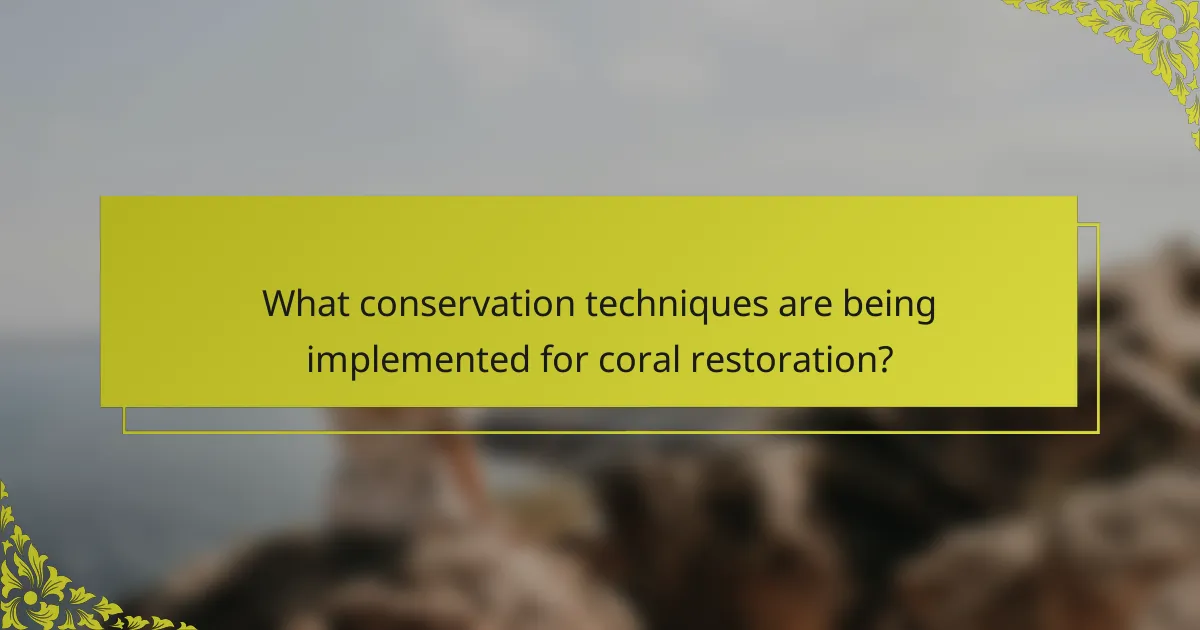
What conservation techniques are being implemented for coral restoration?
Coral restoration techniques for the Great Barrier Reef include coral gardening, artificial reefs, and genetic enhancement. These methods aim to improve coral resilience and biodiversity.
Coral gardening involves cultivating corals in nurseries before transplanting them to degraded areas. This technique enhances recovery rates and allows for selective breeding of resilient coral species.
Artificial reefs provide new habitats for marine life, promoting biodiversity and supporting ecosystem recovery. These structures can be made from various materials, including concrete and recycled materials.
Genetic enhancement focuses on breeding corals that can withstand rising temperatures and acidification. This innovative approach aims to create more resilient coral populations, ensuring long-term survival and ecosystem stability.
How does coral gardening contribute to reef recovery?
Coral gardening significantly aids reef recovery by enhancing coral growth and resilience. This technique involves cultivating coral fragments in controlled environments before transplanting them onto damaged reefs. As a result, it accelerates the restoration process and improves biodiversity. Studies show that coral gardening can increase coral cover by up to 50% in affected areas within just a few years. Additionally, this method fosters genetic diversity, which is crucial for the long-term survival of coral species amid climate change and ocean acidification.
What innovative technologies are being used in coral conservation?
Innovative technologies in coral conservation include artificial intelligence, drone surveillance, and genetic engineering. These methods enhance monitoring, restoration, and resilience of coral ecosystems. For example, AI analyzes data for early warning signs of coral bleaching. Drones provide aerial assessments of reef health, while genetic techniques aim to create more resilient coral strains. These advancements are crucial for preserving the biodiversity of the Great Barrier Reef.
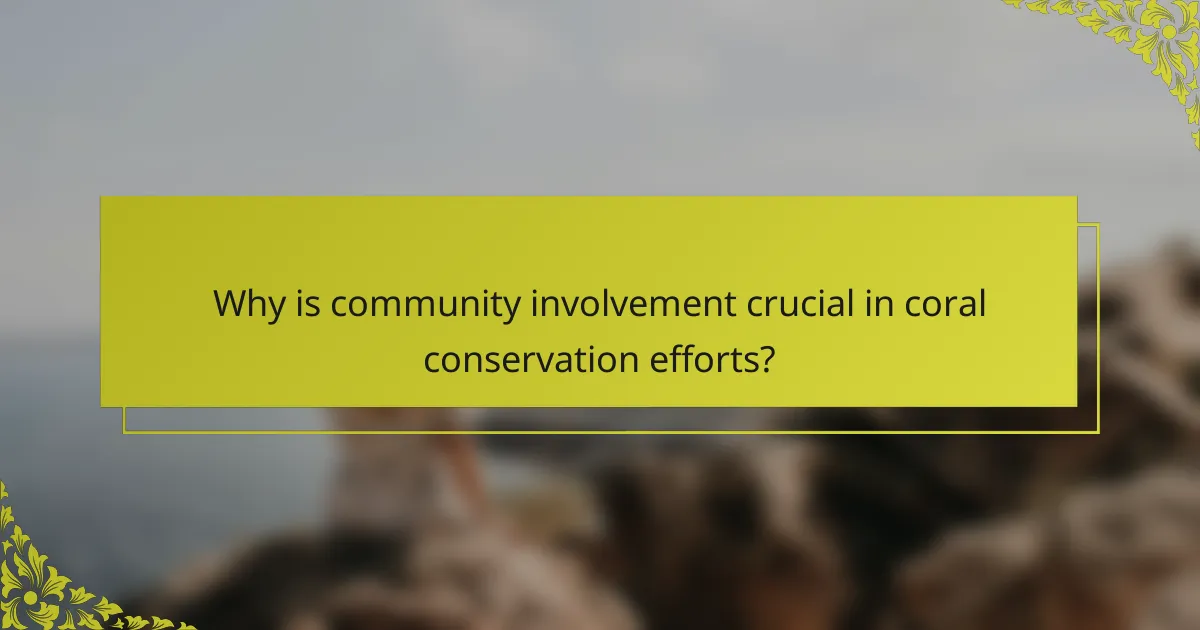
Why is community involvement crucial in coral conservation efforts?
Community involvement is crucial in coral conservation efforts because it fosters local stewardship and enhances awareness. Engaging communities leads to increased support for sustainable practices and better monitoring of coral health. Collaborative initiatives often yield innovative solutions tailored to local ecosystems. For instance, citizen science programs empower individuals to contribute to data collection and reporting, significantly aiding research efforts. Ultimately, strong community ties create a shared responsibility for protecting the Great Barrier Reef’s marine life diversity.
How can local populations contribute to reef protection?
Local populations can significantly contribute to reef protection through active participation in conservation efforts. Engaging in community-led initiatives fosters awareness and promotes sustainable practices. For instance, local groups can organize clean-up activities, monitor reef health, and educate others about marine biodiversity. Collaborative efforts with scientists enhance data collection and improve conservation strategies. Additionally, supporting eco-friendly tourism helps fund reef protection projects and raises awareness about the importance of coral ecosystems. Overall, local involvement is crucial for the long-term sustainability of the Great Barrier Reef.
What educational initiatives promote awareness of reef conservation?
Educational initiatives promoting awareness of reef conservation include community workshops, school programs, and online campaigns. These initiatives aim to educate the public about the Great Barrier Reef’s marine life diversity and coral conservation techniques. For example, local organizations often host workshops that teach sustainable practices and the importance of coral ecosystems. Additionally, schools incorporate reef conservation into their curricula, fostering a new generation of environmentally conscious citizens. Online campaigns utilize social media to reach a wider audience, sharing vital information and encouraging participation in conservation efforts.
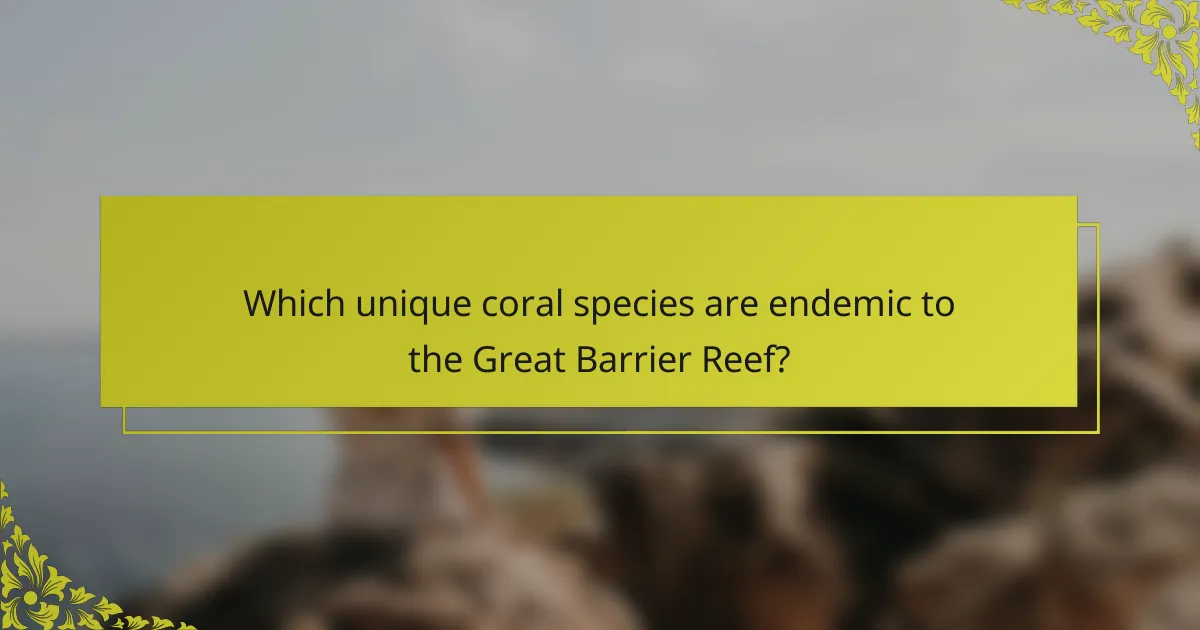
Which unique coral species are endemic to the Great Barrier Reef?
The Great Barrier Reef is home to several unique coral species, including Acropora tenuis and Montipora digitata. These corals exhibit distinct adaptations to their environment. Acropora tenuis thrives in shallow waters, while Montipora digitata is known for its resilience to temperature fluctuations. Conservation efforts are essential for protecting these endemic species, as they contribute significantly to the reef’s biodiversity.
What adaptations allow these species to thrive in their environment?
Species in the Great Barrier Reef thrive through unique adaptations like symbiotic relationships and specialized feeding strategies. For instance, clownfish have a mutualistic relationship with anemones, providing protection and gaining shelter. Coral polyps exhibit a unique attribute by forming calcium carbonate structures, creating habitats for diverse marine life. Additionally, some fish species, like parrotfish, possess rare beak-like teeth that enable them to graze on algae, maintaining coral health. These adaptations collectively enhance survival and ecological balance within this vibrant ecosystem.
How do rare coral formations contribute to the reef’s overall health?
Rare coral formations enhance the Great Barrier Reef’s health by providing unique habitats that support diverse marine life. These formations contribute to biodiversity, which stabilizes the ecosystem. Increased species variety improves resilience against environmental changes, promoting overall reef sustainability. Furthermore, rare corals often serve as indicators of reef health, signaling the impact of climate change and pollution. Protecting these formations is crucial for maintaining the reef’s ecological balance and ensuring the survival of various marine organisms.
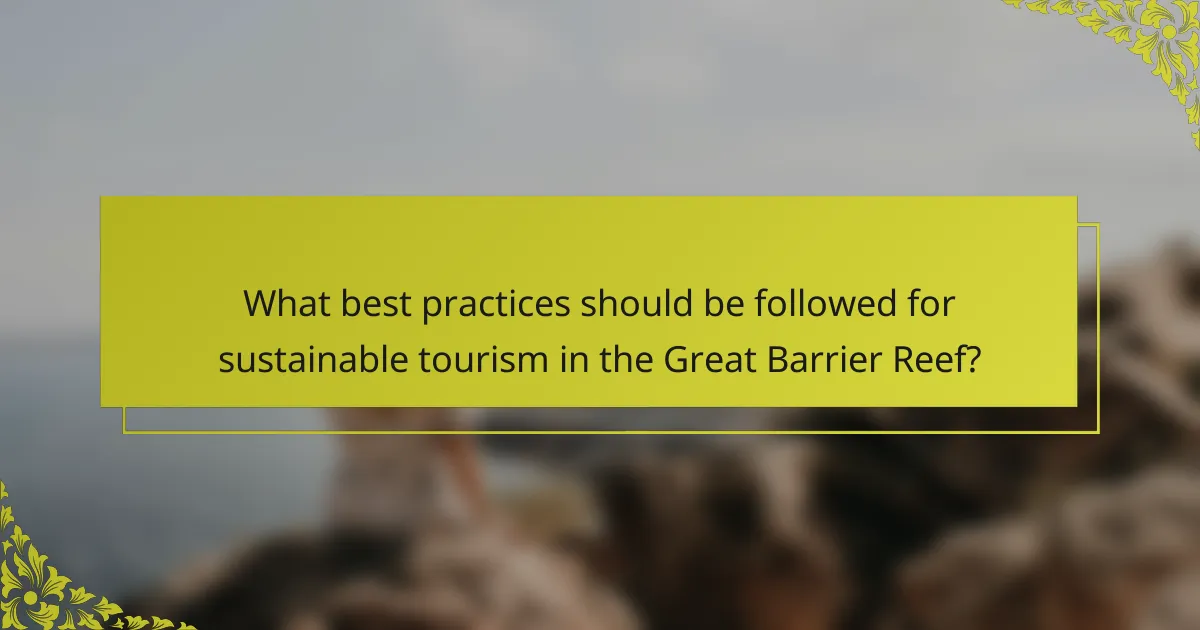
What best practices should be followed for sustainable tourism in the Great Barrier Reef?
Sustainable tourism in the Great Barrier Reef requires minimizing environmental impact, supporting local communities, and promoting conservation. Tour operators should adhere to strict guidelines, such as limiting visitor numbers and using eco-friendly practices. Engaging tourists in educational programs fosters awareness about marine life diversity and coral conservation techniques. Additionally, partnerships with local organizations enhance conservation efforts and ensure tourism benefits the ecosystem and community.
How can visitors minimize their impact on marine ecosystems?
Visitors can minimize their impact on marine ecosystems by following responsible practices. First, avoid touching or stepping on coral reefs, as this can cause damage to fragile coral structures. Second, use reef-safe sunscreen to protect marine life from harmful chemicals. Third, adhere to designated paths and mooring areas to prevent habitat destruction. Fourth, refrain from collecting marine life or shells, which disrupts the ecosystem. Lastly, educate yourself and others about local marine conservation efforts to promote awareness and stewardship. Implementing these practices helps preserve the Great Barrier Reef’s diverse marine life and supports coral conservation techniques.
What guidelines should tour operators follow to ensure responsible practices?
Tour operators should prioritize sustainable practices to protect the Great Barrier Reef’s marine life and coral ecosystems. Implementing guidelines includes minimizing environmental impact, educating tourists, and supporting conservation efforts.
1. Limit visitor numbers to reduce stress on marine life.
2. Use eco-friendly transportation and equipment.
3. Provide educational resources about reef conservation.
4. Collaborate with local conservation organizations.
5. Monitor and assess environmental impact regularly.
